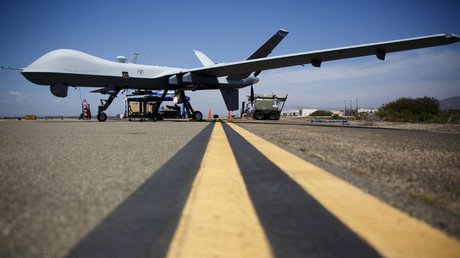US drone warfare relies on ‘near certainty’ of target IDs & collateral damage

The White House has released a redacted copy of the so-called drone strike “playbook”, which outlines US policies on unmanned aerial vehicles, just three years after President Obama promised to make the covert program more transparent.
The redacted 18-page version of the 2013 Presidential Policy Guidance (PPG was made public on Saturday along with other Department of Defense papers), outlining the rules of engagement of targeted killings and the capture of terrorist suspects abroad, under the freedom of information lawsuit filed last year, by the American Civil Liberties Union.
BREAKING: Court forces govt to release White House’s drones “Playbook” in ACLU lawsuit https://t.co/awryon6Mha
— ACLU National (@ACLU) August 6, 2016
The release of the framework for drone strikes “outside the United States and areas of active hostilities,” also follows a US District Court judge order in February requiring the Justice Department to disclose the classified information, and President Barack Obama’s 2013 pledge to offer greater transparency about US counter-terrorism drone operations.
The 2013 document designated the National Security Council (NSC) to review “all operational plans” for US armed forces to either capture or kill the alleged terrorist and to provide legal input for specific operational plans.
The NSC staff, however, it not asked to get involved in carrying out a strike or raid, but rather plays a role in nominating people for inclusion on the so-called “kill list”. It also receives written assessments of the results of each strike.
In general, the disclosed operational plans that are either developed by the CIA or the Pentagon include the decision-making process regarding the timeframe for killing or capturing people, the “strike and surveillance” assets to be used in the operations and the specific counter-terrorism objectives to be achieved.
The Presidential Policy Guidance also seeks a “near certainty” reassurances that civilians will not get killed or injured while hunting down a specific target. The policy however never mentions the term “civilian”, but rather a “non-combatant” which according to the document excludes those individuals who are “targetable in the exercise of national self-defense.”
Strikes against high-value terrorist targets can only be taken “when there is near certainty” that the person is present. Besides targeting specific individuals, drone strikes are also permitted against the “infrastructure, including explosives storage facilities”.
The playbook also stipulates that all operational plans “shall be presented to the president for decision” when there is lack of consensus or the designated target is a US citizen.
Besides the PPG, the White House also released four Pentagon documents. They include the 2014 “Report on Associated Forces,” which outlines the groups the US government considers to be “associated” or “affiliated” with al-Qaida; and a 2013 “Department of Defense Implementation of the Presidential Policy Guidance,” a heavily redacted memorandum shared with Congress.
The two other documents include a March 2014 “Report on Congressional Notification of Sensitive Military Operations and Counterterrorism Operational Briefings,” that outlines the PPG’s congressional reporting requirements; and a 2014 “Report on Process for Determining Targets of Lethal or Capture Operations,” which discusses the legal and policy standards in the PPG.
Following the release of documents National Security Council spokesman Ned Price defended the US drone strikes abroad saying that the US “counter-terrorism actions are effective and legal, and their legitimacy is best demonstrated by making public more information about these actions as well as setting clear standards for other nations to follow.”
READ MORE: ‘No doubt’ US drone strikes killed civilians, Obama says
The release of the documents was welcomed by the ACLU’s deputy legal director, Jameel Jaffer.
“The PPG provides crucial information about policies that have resulted in the deaths of thousands of people, including hundreds of non-combatants, and about the bureaucracy that the Obama administration has constructed to oversee and implement those policies,” Jaffer said in a statement.
Amnesty International has also welcomed the disclosures but cautioned that the redacted version only offers a part of the full picture.
“The Obama administration’s disclosures are welcome but they only tell part of the story and obscure disturbing practices. We still know extremely little about the standards that would govern signature strikes and so-called rescuer strikes, which have involved potentially unlawful killings,” said Naureen Shah, Amnesty’s US director for security and human rights.
Unmanned aerial vehicles have been actively utilized by the Pentagon and CIA for more than a decade of the so-called war on terror. At first, drones were used to gather aerial intelligence but later turned into an effective remote-controlled weapon to eliminate high-value figures in Al-Qaeda and other terrorist organizations. Over the years the drone use has come under much criticism for killing numerous civilians in countries such as Pakistan, Yemen, and Afghanistan.













